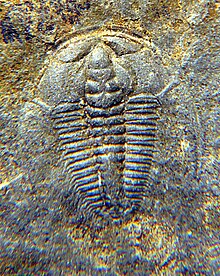Redlichia is a genus of redlichiid trilobite in the family Redlichiidae, with large to very large species (up to 35 centimetres or 14 inches long). Fossils of various species are found in Lower Cambrian (Toyonian)-aged marine strata from China, Korea, Pakistan, the Himalayas, Iran, Spain, southern Siberia, and Antarctica, and from Middle Cambrian (Ordian)-aged marine strata of Australia.
| Redlichia Temporal range:
| |
|---|---|

| |
| Redlichia chinensis | |
| Scientific classification | |
| Domain: | Eukaryota |
| Kingdom: | Animalia |
| Phylum: | Arthropoda |
| Class: | †Trilobita |
| Order: | †Redlichiida |
| Family: | †Redlichiidae |
| Subfamily: | †Redlichiinae |
| Genus: | †Redlichia Cossmann, 1902 |
| Type species | |
| Hoeferia noetlingi Redlich, 1899
| |
| Species | |
| |
| Synonyms | |
|
Hoeferia Redlich, 1899 non Bittner, 1894 | |
Description edit
Redlichia has a rather flat and thinly calcified dorsal exoskeleton of inverted egg-shaped outline, about 1½× longer than wide, measured across the base of the genal spines and disregarding the spine on the 11th segment of the articulated middle part of the body (or thorax). The headshield (or cephalon) is semicircular, about ⅓× as long as the body, with clear genal spines that are a smooth continuation of the border, that extend backward and outward and curving to be near parallel near their tips, which typically extend to the backhalf of the articulated middle part of the body (or thorax). The thorax consists of 11-17 segments, with the 11th from the front bearing a backward directed spine on the midline.
Taxonomy edit
Redlich originally named the genus Hoeferia in 1899. It turned out however, that this name was already given to an arcid bivalve by Bittner in 1894, rendering it an unavailable junior homonym. This is why in 1902, Cossmann renamed Hoeferia Redlich, 1899 as Redlichia, in honor of Redlich.
Mesodema Whitehouse, 1939, Dongshania Lin in Qiu et al., 1983, and Spinoredlichia Liu, 1975, are all considered to be synonyms of Redlichia.[4]
Notable species edit
The type species, R. noetlingi, is found in Lower Cambrian-aged marine strata of Western Pakistan. A similar species, R. chinensis, is found in Lower Cambrian-aged marine strata of China. R. nobilis, is found in Lower Cambrian-aged marine strata of South Korea. It was originally thought that the Kangaroo Island species, R. takooensis, had a small form and a large form: more thorough studies have concluded that the "large morph" is a distinct, carnivorous, possibly cannibalistic species now named R. rex.[2][5]
Reassigned species edit
Some of the species that were originally assigned to Redlichia were later moved to other genera.
- R. blanckenhorni = Redlichops blanckenhorni
- R. finalis = Redlichaspis finalis
- R. nakamurai = Neoredlichia nakamurai
- R. walcotti Lu, 1941= Archaeops lui
- R. walcotti Mansuy, 1912= Saukandiops walcotti
- R. cf. walcotti Saito, 1934= Latiredlichia saitoi
References edit
- ^ Glauert, L. "Determination of the exact localities where Cambrian fossils were collected by E.T. Hardman in 1884" (PDF). Records of the Western Australian Museaum and Art Gallery. 1 (2): 66–72.
- ^ a b James D. Holmes; John R. Paterson; Diego C. García-Bellido (2019). "The trilobite Redlichia from the lower Cambrian Emu Bay Shale Konservat-Lagerstätte of South Australia: systematics, ontogeny and soft-part anatomy". Journal of Systematic Palaeontology. 18 (4): 295–334. doi:10.1080/14772019.2019.1605411. S2CID 196651681.
- ^ Paterson, R.J.; Jago, J.B. (2006). "New trilobites from the Lower Cambrian Emu Bay Shale Lagerstätte at Big Gully, Kangaroo Island, South Australia". Memoirs of the Association of Australasian Palaeontologists. 32: 43–57. hdl:1959.14/10651. ISSN 0810-8889.
- ^ Mikko Haaramo. "Mikko's Phylogeny Archive". Archived from the original on 27 December 2012. Retrieved 6 November 2012.
- ^ Bicknell, Russell D.C.; Holmes, James D.; Pates, Stephen; García-Bellido, Diego C.; Paterson, John R. (2022). "Cambrian carnage: Trilobite predator-prey interactions in the Emu Bay Shale of South Australia". Palaeogeography, Palaeoclimatology, Palaeoecology. 591: 110877. Bibcode:2022PPP...59110877B. doi:10.1016/j.palaeo.2022.110877. S2CID 246790425.
Further reading edit
- Hagadorn, J.W. (2002). "Burgess Shale-type Localities: The global picture". In Bottjer, D.J.; W. Etter; J.W. Hagadorn; C.M. Tang (eds.). Exceptional Fossil Preservation -- A Unique View on the Evolution of Marine Life. Columbia University Press. ISBN 0231102542.
- Greg Edgecombe and the Australian Museum. "Australian Trilobites: A Species List and Bibliography". Retrieved August 23, 2005.
- Sam Gon III. "A guide to the Orders of Trilobites". Retrieved August 23, 2005.
- Nedin, C. (1995). "The Emu Bay Shale, a Lower Cambrian fossil Lagerstätte, Kangaroo Island, South Australia". Memoirs of the Association of Australasian Palaeontologists. 18: 31–40.
- Simpson, Dave. "Trilobites of South Australia". Archived from the original on February 19, 2006. Retrieved August 23, 2005.